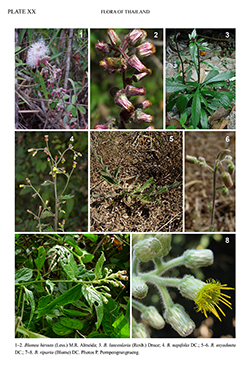e-Flora of Thailand
Volume 13 > Part 2 > Year 2016 > Page 224 > Compositae (Asteraceae) > Blumea
18. Blumea riparia (Blume) DC.wfo-0000074612
Prodr. 5: 444. 1836; Kerr, Fl. Siam. 2(3): 261. 1936; Randeria, Blumea 10: 213. 1960; J.Kost., Blumea 6: 265. 1948; J.Kost., Blumea 20: 312. 1972.— Conyza riparia Blume, Bijdr. Fl. Ned. Ind. 15: 899. 1826. non Kunth. Plate XX: 7–8.
Accepted Name : This is currently accepted.
Synonyms & Citations :
Description : Scandent subshrub or shrub, 0.5–2 m tall; stems erect or scandent, woody at base, glabrate or sparsely puberulous. Leaves petiolate, blade elliptic-oblong to broadly ovate or lanceolate, 1.5–12 by 1–4.5 cm, apex shortly acuminate, base rounded, obtuse or cordate, margins mucronulate-denticulate with rigid teeth, coriaceous, dark green, both surfaces glabrate or sparsely hairy; petioles 0.2–2 cm long. Inflorescences terminal and/or axillary, loose panicles, many capitula per inflorescence, 4–18 cm long. Capitula 6–10 mm diam., peduncles 0.4–1 cm long; involucres broadly campanulate; phyllaries 5-seriate, outer broadly ovate, 0.8–1 mm wide, apex obtuse to acute and puberulous, inner oblong-lanceolate, pubescent; receptacle 3–4 mm diam., flat, alveolate, densely pilose. Marginal floret corollas yellow, basal tube 5.7–6.2 mm long, lobes generally glabrous. Disc floret corollas yellow, basal tube 5.7–6 mm long, glabrous, lobes oblong-lanceolate, 0.5–0.6 mm long, with multicellular and glandular hairs; anthers 1.4–1.5 mm long, apical appendages acute, bases with unbranched tails, anther-tails equal to, or longer than anther collars; style arms 0.6–1.5 mm long; base swollen; acute sweeping hairs distributed to below style bifurcation. Achenes oblong, 10-ribbed, 1–1.8 mm long, setuliferous; pappus bristles 24–35, 4–8 mm long, persistent, white.
Thailand : NORTHERN: Chiang Mai (Doi Inthanon), Nan (Ban Tai); NORTH- EASTERN: Loei (Na Haeo); EASTERN: Nakhon Ratchasima (Khao Laem); SOUTH-WESTERN: Kanchanaburi (Bo Noi); SOUTH-EASTERN: Chanthaburi (Bo Rai, Khao Sabap); PENINSULAR: Chumphon (Paknam, Thako), Ranong (Khao Phota Luang Kaeo), Surat Thani, Krabi (Khao Panom), Nakhon Si Thammarat (Khao Luang, Yong Falls), Pattani (Betong), Narathiwat (Sirindhorn Falls, Bacho).
Distribution : China (Hainan, Guangdong, Yunnan, Guangxi, Hong Kong, Taiwan), India, Bhutan, Nepal, Myanmar, Indochina, Malaysia (Penang, Sabah), Singapore, Indonesia (Sumatra, Java, Kalimantan, Sulawesi, Maluku, West Irian Jaya, Papua), the Philippines (Luzon, Mindanao, Mindoro, Negros, Palawan, Samar, Surigao, Sulu), Papua New Guinea, New Caledonia.
Ecology : Edges or interior of open evergreen forests by streams to mountains, 50–1,500 m alt. Flowering: October–March.
Vernacular : Kamu maeng sang khao (กามุแมงสังขาว)(Chumphon); mu ma sang (มุมะสัง)(Surat Thani).

